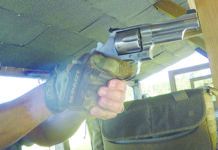The Lead Boogeyman
There were 20 million metric tons of lead bullets fired in the United States in the 20th century. Is that lead having an environmental impact? Not according to research done by Virginia Tech geological scientists.
Analyzing samples from a U.S. Forest Service firing range near Blacksburg, Virginia, Donald Rimstidt, a professor in the Department of Geosciences at Virginia Tech, and other researchers found very little lead damage to the environment. This is a big issue for gun owners, who face opposition from environmentalists over lead deposits. There are 9,000 nonmilitary shooting ranges and a lot of military ones in the United States. Some 60,000 metric tons of lead are expended by shooting (A metric ton or long ton is 2,200 lbs.). So, there are lead shot and bullets everywhere, Rimstidt said.
The scientists were invited by the U.S. Forest Service to look at the shooting range in the National Forest near Blacksburg. The researchers survey found 11 metric tons of shot in the shotgun range and 12 metric tons of lead bullets in the rifle range.
These ranges are 10 years old. Most of the lead shot has accumulated on about four or five acres. Some shots have been into the woods, which cover hundreds of acres, Rimstidt said.
The geologists looked first at lead corrosion and whether lead is leaching into the water table or streams. Lead metal is unstable when it is in contact with air and water. It corrodes and forms hydrocerrussite, the white coating seen on old bullets in museums. That slows corrosion, Rimstidt said. However some lead escapes, he said. But we learned that it is absorbed in the top few inches of soil and does not migrate beyond that, Rimstidt said. Lead is not very mobile. It does not wash away in surface or ground water.
Another finding is that there are large amounts of lead in the trees near the shooting range, but not in a large percentage of the trees, Rimstidt said. If and when those trees are harvested, they would be contaminated with lead. Fisheries and Wildlife professor Pat Scanlon was an investigator on the project until his death in 2003. He found no evidence that birds were eating shot, but this portion of the research was not completed, Rimstidt said. We are not saying that wildlife would not ingest lead, but it does not appear to be a problem on this range. Other shooting ranges may be different.
Rimstidt will give his teams recommendations to the Forest Service representatives so they can develop best management practices. They already knew to put lime on the range to limit corrosion, to take measures to prevent soil erosion, and now, to keep track of the trees if they are cut. They are the experts in management. I will give them the facts, and they will make the decisions, Rimstidt said.
Rimstidts conclusion is that shooting on controlled ranges reduces the overall risk to the public from lead in the environment. Other study results are available in the paper, Lead Behavior at National Forest Shooting Ranges, by Rimstidt, James Craig, and Caleb Scheetz.
-Todd Woodard





















